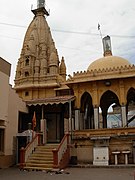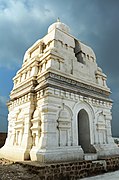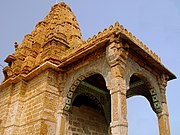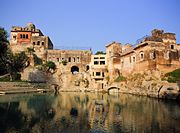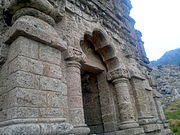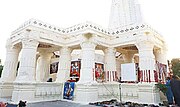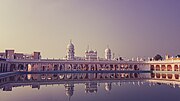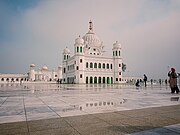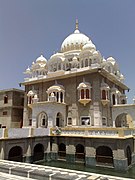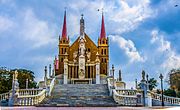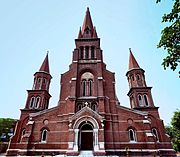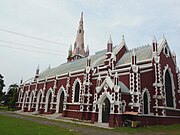Religious Minorities in Pakistan
Pakistan has five major ethno-regional communities in Pakistan: Baloch, Muhajir, Punjabis, Pushtuns and Sindhis, as well as several smaller groups. There are also religious and sectarian groups such as Ahmadis, Christians, Hindus, Kalasha, Parsis and Sikhs, and Shia Muslim sects including Ismailis and Bohras.[1]
According to the 1941 census of India, there were 5.9 million non-Muslims in the territories that came to form Pakistan in 1947 (West Pakistan and East Pakistan (now Bangladesh). During and after Pakistan's independence in 1947, about 5 million Hindus and Sikhs emigrated to India, with Punjab alone accounting for migration of 3.9 million people.[2] According to the 1951 census conducted by the Government of Pakistan, Pakistan had 1.6% Hindu population.[3] In East Pakistan (Bangladesh), non-Muslims comprised 23.2% of the total population.[4][5]
By 1997, the percentage of Hindus remained stable at 1.85% in Pakistan,[6] while Bangladesh has witnessed a decline with Hindus migrating from it because of insecurity due to fear of persecution, conflict, communal violence (as a result of newly created Bangladesh's assertion of its Muslim identity) and poverty.[7][8] The percentage of Hindus in Bangladesh had fallen drastically to 9.2% by 2011, with non-Muslims accounting for 10.2% of the total population.[9] due to disproportionate birth rates between the two communities. The demolition of the Hindu temple site serves as a poignant illustration of the ongoing discrimination endured by the Hindu community in Pakistan.[10] In Pakistan, religious minorities, women, and transgender individuals remain subject to violence, discrimination, and persecution. Authorities frequently fall short in providing sufficient protection and holding perpetrators accountable for their actions.[11]
Much of the decrease in minority populations in Pakistan has occurred due to the events surrounding Partition, and the wars of 1965 and 1971.[12] Forced conversions and marriages occur largely in rural and backward areas in Pakistan. November 2019, Pakistan formed parliamentary committee to stop the act of forced conversion in the country.[13] However, according to "[t]he All Pakistan Hindu Panchayat (APHP)...[the] majority of cases of marriages between Hindu women and Muslim men were result of love affairs. It said due to honour, the family members of women concoct stories of abduction and forced conversions".[14]
Pakistan, from its very first day, used Islam as a state policy. This is evident in the decline in the numbers of minorities. Moreover, Pakistan's first law minister, Jogendar Nath Mandal, clearly stated in his resignation from the cabinet of Prime Minister Liaqat Ali Khan.
"I gave expression to this view of mine. I must say that this policy of driving out Hindus from Pakistan has succeeded completely in West Pakistan and is nearing completion in East Pakistan too."[15]
According to the Western religious freedom and human rights monitoring group Global Human Rights Defence,[16][17] the US Commission on International Religious Freedom, and the United States Department of State, religious minorities face severe discrimination in Pakistan.[18][19][20][21]
However in recent years, Pakistan has seen development in safeguarding the rights of the minorities. For instance in 2019, Supreme Court of Pakistan gave verdict that Christians would be able to register their marriages with an official marriage certificate.[22] In another case, Pakistan opened the Kartarpur Corridor, allowing Sikh pilgrims from around the world to visit Gurdwara Darbar Sahib, one of the holiest shrines in Sikhism, as a goodwill gesture towards minorities.[23] Similarly, a judge in Pakistan nullified the "free-will" marriage of a Hindu girl, Mehik Kumari, and confirmed that she was underage when she "embraced" Islam and married a Muslim man. Activists had argued that Kumari was abducted and forcibly converted to Islam.[24]
Since these events, Pakistan has given over 1 million non-Muslims the right to vote. The number rose to 4.43 million from 3.63 million since 2018.[25]
Despite new allegations of torture and extrajudicial killings emerging, the government of Pakistan has not taken adequate measures to hold law enforcement agencies accountable for these serious abuses. Additionally, Islamist militants have carried out attacks targeting law enforcement officials and religious minorities, resulting in the loss of dozens of lives.[26]
Pakistan's blasphemy laws illustrate one of the most extreme instances of this issue: Since 1990, over 62 individuals have fallen victim to vigilante violence linked to blasphemy accusations. The repercussions of this legal and political marginalization are acutely felt by religious minority groups, impacting their daily lives significantly.[27][28]
Religious minorities
[edit]Demographics
[edit]| Religious minorities | Population | % |
|---|---|---|
| Hindus ( |
4,444,437 | 2.14% |
| Christians ( |
2,637,586 | 1.27% |
| Ahmadiyyas | 207,688 | 0.09% |
| Sikhs ( |
20,768 | 0.01% |
| Others (inc. Jews, Jains, Buddhists, Irreligious) | 20,767 | 0.01% |
| Total | 7,331,246 | 3.53% |
As per 2017 census, Pakistan has a population of 207,684,000.[30]
In 2012, according to the Government of Pakistan's National Database and Registration Authority (NADRA), the population of officially registered religious minorities in Pakistan was as follows:[31]
- Hindus: 1,414,527
- Christians: 1,270,051
- Ahmadis: 125,681
- Baha'is: 33,734
- Sikhs: 6,146
- Parsis: 4,020
- Buddhists: 1,492
- Others: 66,898
According to the 1951 census conducted by the Government of Pakistan, West Pakistan had 1.6% Hindu population, while East Pakistan (now Bangladesh) had 22.05%.[7]
According to the 1998 census conducted by the Government of Pakistan, Hindus made up 1.85% of the population and Christians (Protestant and Roman Catholic) 1.59%, or around 3.2million people.[6] Other estimates put the numbers higher. Historically, there was also a small contingent of Jews in Pakistan who emigrated to Israel in 1948.
The U.S. State Department's International Religious Freedom Report 2002 estimated the Shi'a population to be between 10 and 15%,[32] of which between 550,000 and 600,000 are Ismailis, a sect of Shi'a Muslims and who pay tribute to their living spiritual leader, the Aga Khan.
In a 2011 book, Ishtiaq Ahmed wrote that "Some independent studies, however, suggest that the non-Muslims population of Pakistan is nearly 10 per cent and Hindus, Christians and Ahmadis make up four million each. It is generally noted that while majorities play down minority figures, the minorities inflate them. This is especially true of the Ahmadiyya community. Official statistics return less than 150,000 for them while the Ahmadis claim to be around ten million."[33]
Much of the decrease in minorities of Pakistan has occurred due to the events around the partition, the wars of 1965 and 1971.[12] In November 2019, Pakistan formed parliamentary committee to stop the act of forced conversion in the country.[13]
In 1995, the Parsis put their number at 2,831.[34]
Blasphemy law
[edit]Pakistan's Blasphemy law stems from section 295-C of the Pakistan Penal Code (6 October 1860) XLV of 1860. It states that whoever "defiles the sacred name of the Holy Prophet Muhammad (peace be upon him) shall be punished with death, or imprisonment for life, and shall also be liable to fine."[35] This law is phrased in vague terms (therefore violating the principle of legality), and is often used to level false accusations at people from religious minorities. Asia Bibi is a notable example of a person against whom such a violation occurred. Victims of these false accusations are often presumed guilty, and can be convicted without substantive evidence.[18]
Independent human rights organisation Global Human Rights Defence receives a number of cases each month from the representatives of victims of the blasphemy law.[18][16]
According to the 2012 United States Commission on International Religious Freedom (USCIRF) annual report, "The government of Pakistan continues to engage in and tolerate systematic, ongoing, and egregious violations of freedom of religion or belief."[19][36] The USCIRF has designated Pakistan as "country of particular concern" since 2002.[19][37] The report argues that "The country’s blasphemy laws, used predominantly in Punjab but also nationwide, target members of religious minority communities and dissenting Muslims and this frequently results in imprisonment. The USCIRF is aware of at least 16 individuals on death row and 20 more serving life sentences. The blasphemy law, along with anti-Ahmadi laws that effectively criminalise various practices of their faith, has created a climate of vigilante violence. Hindus have suffered from the climate of violence and hundreds have fled Pakistan for India."[38]
Farahnaz Ispahani who was the media advisor to the President of Pakistan from 2008 to 2012, has blamed the successive Pakistani governments of pursuing a "slow genocide" against minorities to shore up their political base.[39] A BBC FAQ notes that "Beginning in 1980, a slew of clauses was added to the chapter of religious offences in the Pakistan Penal Code. These clauses can be grouped into two categories - the anti-Ahmadi laws and the blasphemy laws." The BBC notes that there is widespread popular support for these laws in Pakistan, and that two prominent critics of these laws, Salman Taseer and Shahbaz Bhatti, have been assassinated in 2011. Regarding the blasphemy laws, the BBC observes that: "Hundreds of Christians are among the accused - at least 12 of them were given the death sentence for blaspheming against the Prophet."[40]
Mass anti-Christian violence recently occurred in the 2009 Gojra riots and in the 2013 Joseph Colony riot and the 2013 Gujranwala riot.[41] Recent anti-Shia violence includes the February 2012 Kohistan Shia Massacre, the August 2012 Mansehra Shia Massacre[42] and the particularly deadly January 2013[43] and February 2013 Quetta bombings.[44] The Ahmadiyya community in Pakistan was targeted in the similarly deadly May 2010 attacks on Ahmadi mosques in Lahore.[45][46]
A survey carried out by All Pakistan Hindu Rights Movement Pakistan's revealed that out of 428 Hindu temples in Pakistan only around 20 survive today and they remain neglected by the Evacuee Trust Property Board which controls those while the rest had been converted for other uses since 1990.[47] However, in November 2019, government of Pakistan started restoring process for 400 Hindu temples in Pakistan. After restoration, the temples will be reopened to Hindus in Pakistan.[48]
Forced conversion
[edit]As of 2013, the Human Rights Commission of Pakistan reported that cases of forced conversion are increasing.[49][50] because over the past few years, laws governing the rights of religious minorities in Pakistan have changed from neutral to explicitly discriminatory.[51] A 2014 report by the Movement for Solidarity and Peace (MSP) says about 1,000 women in Pakistan are forcibly converted to Islam every year (700 Christian and 300 Hindu).[52][53][54] However, an opposing view also exists and was recently documented in an interview published in The Times of India; "[t]he All Pakistan Hindu Panchayat (APHP)...[says the] majority of cases of marriages between Hindu women and Muslim men were result of love affairs. It said due to honour, the family members of women concoct stories of abduction and forced conversions".[55]
Sikhs in Hangu district stated they were being pressured to convert to Islam by Yaqoob Khan, the assistant commissioner of Tall Tehsil, in December 2017. However, the Deputy Commissioner of Hangu Shahid Mehmood denied it occurred and claimed that Sikhs were offended during a conversation with Yaqub though it wasn't intentional.[56][57][58][59]
Many Hindu girls living in Pakistan are kidnapped, forcibly converted and married to Muslims.[60] According to the National Commission of Justice and Peace and the Pakistan Hindu Council (PHC) around 1000 Christian and Hindu minority women are converted to Islam and then forcibly married off to their abductors or rapists. This practice is being reported increasingly in the districts of Tharparkar, Umerkot and Mirpur Khas in Sindh.[61] According to another report from the Movement for Solidarity and Peace, about 1,000 non-Muslim girls are converted to Islam each year in Pakistan.[62] According to the Amarnath Motumal, the vice chairperson of the Human Rights Commission of Pakistan, every month, an estimated 20 or more Hindu girls are abducted and converted, although exact figures are impossible to gather.[63] In 2014 alone, 265 legal cases of forced conversion were reported mostly involving Hindu girls.[64]
Within Pakistan, the southern province of Sindh had over 1,000 forced conversions of Christian and Hindu girls according to the annual report of the Human Rights Commission of Pakistan in 2018. According to victims' families and activists, Mian Abdul Haq, who is a local political and religious leader in Sindh, has been accused of being responsible for forced conversions of girls within the province.[65]
Gallery
[edit]Hindu Temples
[edit]-
The Swaminarayan Temple in Karachi
-
Katas Raj Temples display characteristics of Kashmiri Hindu temples
-
Varun Dev Mandir at Karachi
-
Katas Raj Temples (4th century)
-
One of the Amb Temples constructed between the 7th and 9th centuries
-
Shawala Teja Singh Temple after Renovation by the Government
Gurdwaras
[edit]-
Golden dome of Gurdwara Dera Sahib in Lahore
-
Gurdwara Panja Sahib in Punjab
Churches
[edit]-
Night view of St Mary's Cathedral & Bishop's House in Multan Cantt
-
Outside of the Sialkot Cathedral
See also
[edit]- Demographics of Pakistan
- Languages of Pakistan
- Minority rights
- Hinduism in Pakistan
- Christianity in Pakistan
- Judaism in Pakistan
- Pakistan National Commission for Minorities
- Forced conversion of minority girls in Pakistan
- Secularism in Pakistan
References
[edit]- ^ REPORT: Religious Minorities in Pakistan (by Dr Iftikhar H. Malik). Accessed 31 January 2024.
- ^ Kosinski, Leszek A.; Elahi, K. Maudood, eds. (2012). Population Redistribution and Development in South Asia. Springer Science & Business Media. p. 136. ISBN 9780706908374.
- ^ D'Costa, Bina (2011). Nationbuilding, Gender and War Crimes in South Asia. Routledge. ISBN 978-0-415-56566-0.
- ^ Rawat, Mukesh (12 December 2019). "No, Pakistan's non-Muslim population didn't decline". India Today. Retrieved 16 December 2019.
- ^ Kabir, Muhammad Ghulam (1980). Minority Politics in Bangladesh. Vikas. p. 2. ISBN 9780706908374.
- ^ a b Population by Religion, Census of Pakistan Archived 2010-11-13 at the Wayback Machine
- ^ a b D'Costa, Bina (2011), Nationbuilding, Gender and War Crimes in South Asia, Routledge, pp. 100–, ISBN 978-0-415-56566-0
- ^ Ganguly-Scrase, Ruchira; Lahiri-Dutt, Kuntala (2016), Rethinking Displacement: Asia Pacific Perspectives, Routledge, pp. 100–, ISBN 978-0-415-56566-0
- ^ "Census of Bangladesh". Banbeis.gov.bd. Archived from the original on 6 July 2011. Retrieved 8 June 2013.
- ^ "Hindu Countries 2023". worldpopulationreview.com. Retrieved 26 August 2023.
- ^ Human Rights Watch (21 December 2020), "Pakistan: Events of 2020", English, retrieved 28 July 2023
- ^ a b "Cleansing Pakistan of Minorities" (PDF). Retrieved 18 November 2019.
- ^ a b "Pak. forms parliamentary committee to prevent forced conversions of minorities". The Hindu. 23 November 2019.
- ^ Rana, Yudhvir (30 January 2020). "Most marriages between Hindu women and Muslim men result of love affairs, not abduction, says All Pakistan Hindu Panchayat". The Times of India. Retrieved 3 March 2020.
- ^ "Jogendra Nath Mandal's Resignation letter To PM Liaqat Ali Khan". fruit-chat.com. 29 September 2023. Retrieved 22 March 2024.
- ^ a b "Open Complaint Letter to the UN Human Rights Council: Subject: Forced conversion of underage girls from minority communities in Pakistan". Global Human Rights Defence. 26 March 2019. Archived from the original on 8 April 2019. Retrieved 3 June 2019.
- ^ "GHRD Written Submission to UN Human Rights Council – 41st Regular Session". Global Human Rights Defence. 3 June 2019. Retrieved 31 August 2020.
- ^ a b c GHRD Human Rights Report 2019 (PDF) (Report). Global Human Rights Defence. 7 March 2019. Archived from the original on 19 September 2019. Retrieved 13 September 2022.
- ^ a b c Sen, Ashish Kumar (30 April 2013). "Pakistan tops worst list for religious freedom". The Washington Times. Retrieved 9 May 2013.
- ^ "US report speaks of 'crisis for minorities'". Dawn. AFP. 2 May 2013. Retrieved 9 May 2013.
A US government-appointed panel urged Washington on Tuesday to step up pressure on Pakistan over religious freedom, alleging that risks to its minorities have reached a crisis level.
- ^ "Deeply concerned over reports of human rights abuses, religious discrimination in Pakistan, says US". Business Today (India). 22 October 2019.
- ^ "Supreme Court orders registration of Christian marriages". Samaa TV. Retrieved 2 May 2021.
- ^ "Goodwill gesture, Pakistan opens corridor to Sikh shrine for Indian pilgrims". The Washington Post. 9 November 2019.
- ^ "Pakistan court nullifies converted minor Hindu girl Mehak Kumari's marriage - OrissaPOST". Pakistan Court nullifies converted minor Hindu girl Mehak Kumari's marriage. 19 February 2020. Retrieved 2 May 2021.
- ^ Khan, Iftikhar A. (20 December 2022). "Pakistan enrols one million non-Muslim voters in four years". DAWN.COM. Retrieved 21 December 2022.
- ^ Human Rights Watch (21 December 2020), Pakistan: Events of 2020, retrieved 31 July 2023
- ^ Munshey, Menaal; Zahid, Haya. "Inequality and Discrimination faced by Religious Minorities in Pakistan | OHRH". Retrieved 31 July 2023.
- ^ "Religious minorities do not feel safe in Pakistan". DNA India. Retrieved 31 July 2023.
- ^ https://www.pbs.gov.pk/sites/default/files//population_census/sailent_feature_%20census_2017.pdf [bare URL PDF]
- ^ "Pakistan's population is 207.68m, shows 2017 census result - Pakistan - DAWN.COM". 19 May 2021.
- ^ "Over 35,000 Buddhists, Baha'is call Pakistan home". The Express Tribune. 2 September 2012. Retrieved 30 July 2019.
- ^ Pakistan, International Religious Freedom Report 2002 (Report). United States Department of State Bureau of Democracy, Human Rights, and Labor. 7 October 2002.
- ^ Ishtiaq Ahmed (2011). The Politics of Religion in South and Southeast Asia. Taylor & Francis. p. 82. ISBN 978-1-136-72703-0.
- ^ Yousafzai, Arshad (29 April 2018). "Two decades from now, Pakistan will have no Parsis". The News International. Karachi.
- ^ "Pakistan Penal Code (Act XLV of 1860)". Retrieved 3 June 2019.
- ^ "U.S. Commission on International Religious Freedom Annual Report 2012 | OSCE". osce.org. Retrieved 30 July 2019.
- ^ "Tier 1 Countries of Particular Concern". United States Commission on International Religious Freedom. Retrieved 30 July 2019.
- ^ Amina Jilani (10 May 2013). "Of particular concern". The Express Tribune.
- ^ "Slow genocide of minorities in Pakistan: Farahnaz Ispahani Mint". Mint.
- ^ "Q&A: Pakistan's controversial blasphemy laws". 20 November 2012. Archived from the original on 20 November 2012.
- ^ Sonya Rehman (5 April 2013) Joseph Colony: Attacked and Unprotected, The Diplomat thediplomat.com/the-pulse/2013/04/05/joseph-colony-christian-community-in-lahore-attacked-and-unprotected/2/?all=true
- ^ "Pakistan Shias killed in Gilgit sectarian attack". BBC. 16 August 2012. Retrieved 10 January 2020.
- ^ Formidable power of Pakistan's anti-Shia militants www.bbc.co.uk/news/world-asia-20983153
- ^ Sattar, Abdul; Zada, Shirin (10 January 2013). "Bombings kill 115 people in Pakistan". USA Today. Retrieved 30 July 2019.
- ^ "Lahore tense after mosques' attacks". Al Jazeera English. 28 May 2010. Archived from the original on 29 May 2010. Retrieved 28 May 2010.
- ^ "Pakistan mosque attacks in Lahore kill scores". BBC News. 29 May 2010.
- ^ Gishkori, Zahid (25 March 2014). "95% of worship places put to commercial use: Survey". The Express Tribune. Retrieved 13 October 2017.
- ^ "Pakistan to restore, hand over 400 Hindu temples". Gulf News. 13 November 2019.
- ^ United Nations High Commissioner for Refugees (30 April 2013). "Refworld – USCIRF Annual Report 2013 – Countries of Particular Concern: Pakistan". Refworld. Retrieved 5 May 2015.
- ^ "Pakistan: Religious conversion, including treatment of converts and forced conversions (2009–2012)" (PDF). Responses to Information Requests. Government Research Directorate, Immigration and Refugee Board of Canada. 14 January 2013. Archived (PDF) from the original on 4 May 2017. Retrieved 17 January 2018.
- ^ Ali, Naziha Syed (17 July 2017). "The truth about forced conversions in Thar". DAWN.COM. Retrieved 29 April 2023.
- ^ "1,000 Christian, Hindu girls forced to convert to Islam every year in Pakistan: report". India Today. 8 April 2014. Retrieved 19 January 2018.
- ^ Anwar, Iqbal (8 April 2014). "1,000 minority girls forced in marriage every year: report". Dawn. Retrieved 25 July 2014.
- ^ "India ruling party chief urges law against religious conversions". Dunya News. New Delhi. 20 December 2014. Archived from the original on 3 December 2019. Retrieved 13 September 2022.
- ^ Rana, Yudhvir (30 January 2020). "Most marriages between Hindu women and Muslim men result of love affairs, not abduction, says All Pakistan Hindu Panchayat". The Times of India. Retrieved 3 March 2020.
- ^ "Sikh community in Hangu 'being forced to convert'". The Express Tribune. 16 December 2017. Retrieved 16 January 2018.
- ^ "Sikhs in Pakistan complain of pressure to convert". 16 December 2017. Retrieved 16 January 2018.
- ^ "Sikhs told to 'convert to Islam' by Pakistani official". Rabwah Times. 16 December 2017. Retrieved 16 January 2018.
- ^ Anwar, Madeeha (23 December 2017). "Authorities Investigate Cases of Forced Conversion of Sikh Minority in Pakistan". Extremism Watch Desk. Voice of America. Retrieved 16 January 2018.
- ^ Forced conversions torment Pakistan's Hindus | India | Al Jazeera
- ^ Forced conversions of Pakistani Hindu girls - Daily Times
- ^ "1,000 Christian, Hindu girls forced to convert to Islam every year in Pakistan: Report".
- ^ "Pakistan, Hindus, Forced Conversions, Islam".
- ^ "265 cases of forced conversion reported last year, moot told". 20 March 2015.
- ^ "Forced conversions, marriages spike in Pakistan". religionnews.com. 6 June 2019.
External links
[edit]- Jews in Pakistan. An article by Prof. Adil Najam of The Fletcher School of Law and Diplomacy, Tufts University.

